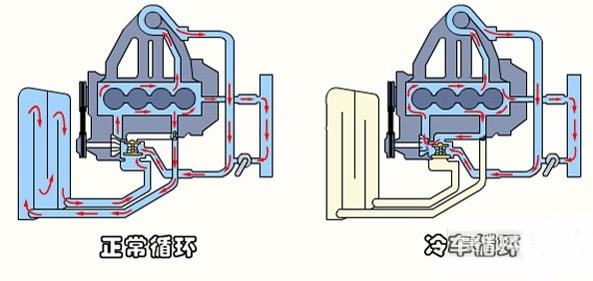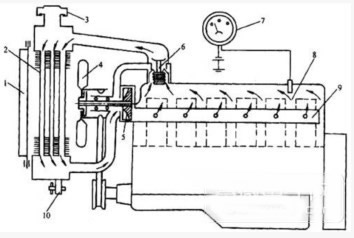In automotive power systems, engine cooling systems play a very important role. When the engine is working, the cooling system can properly adjust and control the temperature, so that the various components of the engine can maintain the normal working temperature, thereby obtaining an ideal power output and reducing fuel waste. If there is no help from the cooling system, the engine will not work properly. This article briefly introduces the role and design of the automotive engine cooling system, hoping to help readers learn!
This article refers to the address: http://
The automobile engine cooling system is a forced circulation water cooling system. In short, the water pump is used to increase the pressure of the coolant, and the coolant is circulated in the engine. The cooling system is mainly composed of a Cooling Fan, a compensation Water Tank, a water pump, a radiator, an engine body, a thermostat, a water jacket in the cylinder head, and an attachment device.
In the cooling system, there are actually two heat-dissipating cycles: one is to cool the main cycle of the engine, and the other is the in-vehicle heating cycle. Both cycles are centered on the engine and the same coolant is used.
Cooling the main cycle of the engine
The main cycle includes two work cycles, namely "cold cycle" and "normal cycle". After the cold car is in the car, the engine is gradually warming up, and the temperature of the coolant can not open the thermostat in the system. At this time, the coolant only passes through the pump to perform the "cold cycle" in the engine, so that the engine can reach the engine as soon as possible. Normal operating temperature. As the temperature of the engine rises, the temperature of the coolant rises to the temperature at which the thermostat is turned on (usually after 80 ° C), and the cooling cycle begins a "normal cycle." At this time, the coolant comes out of the engine, passes through the radiator at the front end of the car, dissipates heat, and then enters the engine through the water pump.

In-vehicle heating cycle
This is a heating cycle, but for the engine it is also an engine cooling cycle. The coolant passes through the heating device inside the car, and the heat of the coolant is sent into the car and then returned to the engine. One difference is that the heating cycle is not controlled by the thermostat, as long as the heater is turned on, the cycle begins, regardless of whether the coolant is cold or hot.
The role of the car engine cooling system
When it comes to cooling systems, we first need to understand the effect of temperature on the engine. The working cycle of the automobile engine is carried out at a high temperature, and the temperature of the mixture entering the cylinder can be burned up to 2000 degrees Celsius or higher. At this time, the piston, cylinder, cylinder head, valve and other components of the engine are in contact with the high-temperature combustible mixture and are strongly heated. At this time, if the engine is not effectively cooled, the mechanical strength will be deteriorated, and the cylinder inflation coefficient will be lowered. The air-fuel ratio imbalance causes the engine to burn abnormally.

Excessive temperature in the cylinder will cause the mixture to prematurely burn (premature combustion), resulting in severe knocking of the engine. Excessive temperature will also cause the lubricating oil to burn and deteriorate. At high temperatures, the clearance in the cylinder will be reduced, the protection of the oil film will be destroyed, and the lubricating ability will be reduced. In severe cases, it will cause adhesive wear and jam (cylinder) failure. .
In order to avoid these adverse consequences, to make the engine run normally and to exert the proper power output, and to get better performance in economy, power and durability, the active work of the cooling system is indispensable. However, for engine operating conditions at low temperatures, excessive cooling can also adversely affect the engine.
First of all, in order to consider the phenomenon of thermal expansion and contraction, the car engine will have a certain gap between the intake and exhaust valves, the piston and the cylinder liner to match the normal temperature and the good agreement between the components. Taking the piston and the cylinder liner, the long-term low temperature causes a large gap, which may result in leakage and oil leakage. The abnormal combustion will increase the power consumption and increase the fuel consumption.
In addition, in the low temperature state, the evaporative performance of the combustible mixture is low, resulting in poor atomization effect, resulting in insufficient combustion of the engine, increasing fuel consumption and easily forming carbon deposits inside the engine. The viscosity of the engine lubricating oil rises at a low temperature, and the fluidity deteriorates, resulting in uneven lubrication, which exacerbates internal wear.
In general, the operating temperature is too high or too low, which not only increases the fuel consumption, but also increases the engine wear and affects the service life. When the temperature of the engine is 40 degrees Celsius, the wear amount is 5 times that of 90 degrees. If the temperature is too high, the mechanical strength of the engine parts will decrease, which will cause premature engine damage.
Design of automotive engine cooling system
The function of the cooling system is to ensure that the engine works at the optimum temperature under all working conditions. The suitability of the cooling system will directly affect the service life and fuel economy of the engine. Therefore, in the design and calculation of the cooling system, The selection of the heat sink and the matching of the fans play a crucial role in the cooling system.
In order to facilitate the organization of the airflow, the radiator is arranged in front of the whole vehicle, but due to the limitation of the layout space of the whole vehicle, an air conditioning condenser is arranged in front of it, which increases the wind resistance and affects the air intake of the radiator, thereby affecting the cooling system. Cooling capacity. The fan is placed behind the radiator and driven by the fan motor.
What is the role of the car engine cooling system? The above is a brief introduction to Xiaobian. I believe readers have an understanding of this aspect. In general, the cooling system is to ensure that the engine works at the optimum temperature under working conditions. The cooling system affects the engine's power performance, service life and fuel economy. It plays a very important role in the engine.
The cooling system of water-cooled computer can not leave the water pump, water pump is the key to push the liquid flow. Water pump is a heart of one water cooling system, without water pump, the whole will not form a circulation, water pump of the water cooling likes the engine if the car, they both have the output power.displacement.rotate speed and so on,Water pumps correspond to lift, flow speed and power.
12V Dc Mini Water Pump For Pc,Dc Mini Water Pump,12V Dc Mini Water Pump,Pressure Water Pump
Dongyuan Syscooling Technology Co., Ltd. , https://www.syscooling.com